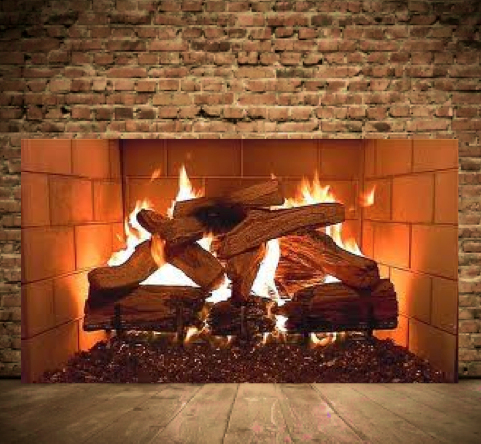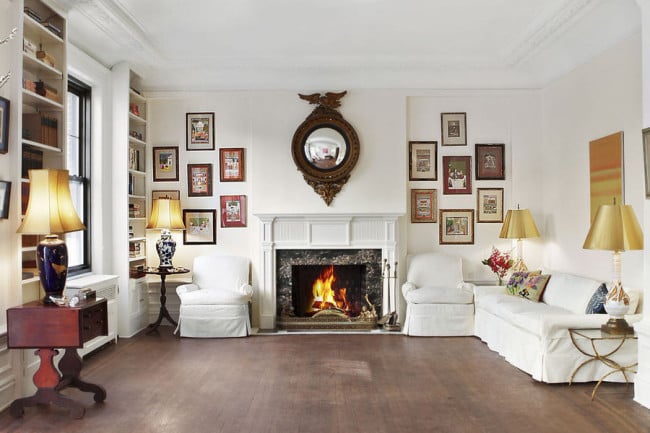How to make sure your NYC fireplace is ready for the cold season
The wood-burning fireplace. For some it's the New York City real estate holy grail, while for others who have one, it's just one more thing to worry about. Those with a fireplace are in a particularly exclusive club now, because as of July 2014, the New York City building code outlaws the creation of any new ones, wood-burning ones anyway (developers can still include gas fireplaces in new apartments).
The new regulation, part of a clean air initiative, also requires people with existing wood-burning fireplaces to use wood with a moisture content of 20 percent or less. Don't worry if you don't have your moisture meter handy: we're told wood from Home Depot, Lowe's and even the corner bodega should fit the bill just fine. If you want to up the ante, check out The Woodman, which delivers.
But you know what they say about playing with fire. Don't. Which is why if you've got a wood-burning fireplace and are thinking of firing it up when temperatures drop, there are some basic steps you need to take to keep safe.
What you need to do to prep a fireplace depends on your previous use
If you've used your fireplace in the last year, and you're a casual user making fires 10-20 times a year, have the fireplace checked and cleaned, and the flues swept or cleared, a process that will cost $150-$250 or so. Also, in general, it's important to have the fireplace inspected every other year.
If a fireplace is new-to-you and you have no idea of its history or condition, have a full inspection done. Depending on the company, if you're having more than one fireplace inspected, etc. rates run about $200-$600. A video inspection will show the condition of the flue (the vertical chamber through which smoke escapes) as well as the smoke chamber and the area just over the firebox (the firebox being jargon for where the fire is actually built). A video inspection will also typically include a look at the boiler chimney and flue, which often run in the same bank as the fireplace.
In addition to a video inspection, a visual inspection should be done of the brick mortar, as well as the damper door, which opens and closes to let smoke out or keep air from coming in. Word to the wise: It's a good idea to check the license of any chimney maintenance company with the New York City Department of Consumer Affairs.

What might a fireplace inspection find? Plenty!
It's not uncommon for flues to be blocked, due to natural deterioration of the lining or brick, or by a furry friend.
"Squirrels and raccoons love chimneys. We don't know why, but they do," says Anthony Fisher, owner of TC Builders Corp., which specializes in prewar and brownstone fireplace work in Manhattan and Brooklyn.
Other issues, says Fisher, can include a damaged or nonexistent lining, worn and broken dampers, and the deterioration of divider walls between chimney flues. Replacing or repairing a liner is not an inexpensive proposition, with costs varying on the type—expect to pay at least $2,000. Some companies, such as Allen Chimeys LLC, which services Essex County and the surrounding areas, will only replace liners, with new, stainless steel ones that come with a lifetime guarantee, and a price tag of $3,500-$5,000. (The company's Jillian Allen cites the brittle terra-cotta tiles of older liners as the reason, as they can continue to deteriorate after a repair.)
Dampers range in size, anywhere from 18-42 inches, and replacements costs vary widely, from about $400-$800. Installing a universal rooftop damper is an alternative to matching your existing damper. As with other dampers, a handle on the inside of the fireplace opens and closes this kind.
To prevent debris and critters from getting in the chimney, a rain cap can be installed.
You'll also want some essential accessories before you get cozy
"You should not use a fireplace regularly without some kind of screen," Fisher says. "The wood pops and crackles, and sometimes it likes to pop out of the fireplace. Some people opt for glass doors over a screen, and either is fine."
A basic tool set of a poker, tongs, a broom, and a shovel are also good to have. (Note: never remove ashes before they are completely cooled.)
Finally, it's a good idea to get a grate, which is the metal cradle that supports and elevates the wood. It helps create airflow, particularly in older, smaller fireplaces.
And remember, on that first chilly day or night when you can't seem to get the fire literally going: make sure the damper is open. And it never hurts to crack a window to give the fire some air.
"It's a combustion chamber," says Fisher. "It needs fuel, a spark, and some air."
You Might Also Like



























